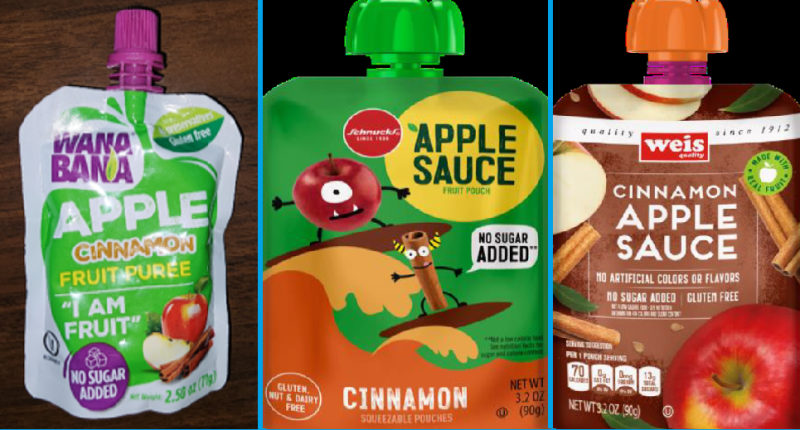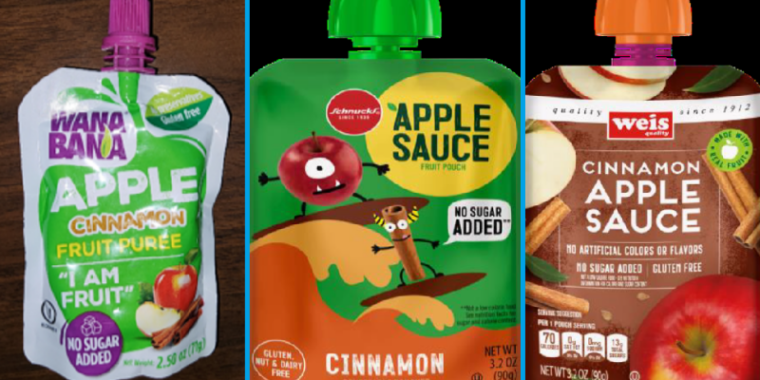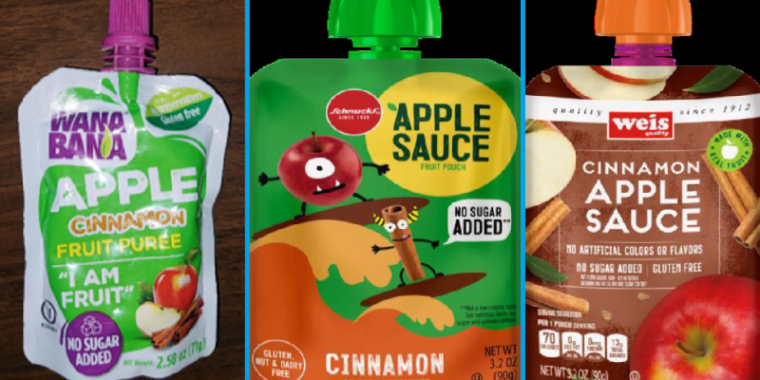We may now know who’s behind the lead-tainted cinnamon in toddler fruit pouches

Enlarge / The three recalled pouches linked to lead poisonings.
A spice grinder named Carlos Aguilera of Ecuador is the likely source of contaminated cinnamon containing extremely high levels of lead and chromium, which made its way into the apple cinnamon fruit pouches of US toddlers, according to an announcement by the Food and Drug Administration this week.
To date, there have been 413 cases of poisoning across 43 US states, according to the Centers for Disease Control and Prevention.
The FDA said Ecuadorian officials at the Agencia Nacional de Regulación, Control y Vigilancia Sanitaria (ARCSA) identified Aguilera as the cinnamon processor and reported to the FDA that his business is no longer operating. Aquilera received raw cinnamon sticks sourced from Sri Lanka, which, according to raw sample testing conducted by ARCSA, had no lead contamination upon their arrival. After Aguilera processed the cinnamon, it was supplied by a company called Negasmart to Austrofoods, the manufacturer of the apple cinnamon pouches.
According to FDA inspection documents obtained by CBS News, Austrofoods never tested its product for heavy metals at any point in production and repeatedly failed to identify the cinnamon as a raw ingredient needing such testing. “[Y]ou did not sample and test the raw material or the finished product for heavy metals,” the FDA wrote in its inspection report. Testing by the FDA immediately identified high levels of lead in the finished apple cinnamon puree and in the ground cinnamon powder Austrofoods used for the purees. The regulator also observed problems with Austrofood’s pasteurization and sanitation procedures, and noted equipment in poor condition that could have allowed metal pieces to break loose and get into food products.
Austrofood’s apple cinnamon fruit puree pouches were sold under three brands, all of which have been recalled: WanaBana apple cinnamon fruit puree pouches, Schnucks brand cinnamon-flavored applesauce pouches, and Weis brand cinnamon applesauce pouches.
The FDA reported that ARCSA’s investigation and legal proceedings are still ongoing to determine the ultimate responsibility for the contamination. The FDA acknowledged that it has “limited authority over foreign ingredient suppliers who do not directly ship product to the US. This is because their food undergoes further manufacturing/processing prior to export. Thus, the FDA cannot take direct action with Negasmart or Carlos Aguilera.”
Testing by the FDA hints that the cinnamon was contaminated with lead chromate, a vibrant yellow substance often used to bolster a spice’s appearance and weight artificially. It’s frequently been found contaminating turmeric sourced from India and Bangladesh.
The children exposed to the purees face uncertain long-term health effects. The effects of ingesting chromium are unclear, and it’s also not clear what form of chromium the children ingested from the pouches. Lead, on the other hand, is a potent neurotoxic metal that can damage the brain and nervous system. In young children, the effects of acute exposures could manifest as learning and behavior problems, as well as hearing and speech problems in the years to come.
Last year, the CDC reported that exposed children had shown blood lead levels as high as 29 micrograms per deciliter (µg/dL), more than eight times the 3.5 µg/dL threshold the agency considers the cutoff for high exposure.
We may now know who’s behind the lead-tainted cinnamon in toddler fruit pouches Read More »

